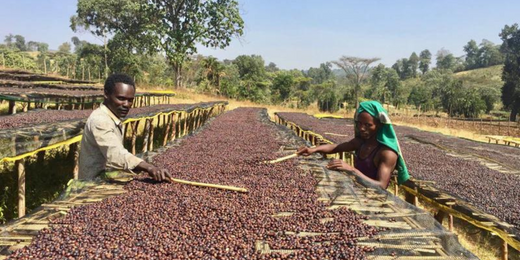Ihr Warenkorb ist leer
Versandkostenfrei in DE ab 39 € // neue Seminartermine jeden ersten Freitag im Monat!
Versandkostenfrei in DE ab 39 € // neue Seminartermine jeden ersten Freitag im Monat!
Versandkostenfrei in DE ab 39 € // neue Seminartermine jeden ersten Freitag im Monat!
Versandkostenfrei in DE ab 39 € // neue Seminartermine jeden ersten Freitag im Monat!

Juli 29, 2022 3 min lesen.
Äthiopien ist, gemeinsam mit dem Südsudan, als Geburtsland des Arabica-Kaffees bekannt. Das im Nordosten Afrikas gelegene Land hat wenige, große Farmen auf denen Kaffee angebaut wird. Dennoch findet es sich unter den Top 10 der weltweiten Kaffeeproduzenten. Grund dafür ist, dass der Kaffee hier hauptsächlich in Waldgärten wächst. Äthiopische Kaffee-Farmer*innen verfügen oft nur über eine kleine Anbaufläche, die nicht selten ihr eigener Garten ist. Insgesamt sind in Äthiopien 15 Millionen Menschen am Kaffeeanbau beteiligt.
Die „wilde Anbauweise“ führt unter anderem dazu, dass äthiopischer Kaffee, im Gegensatz zu den meisten anderen Kaffees, nur selten einer eindeutigen Varietät zugeordnet werden kann. Stattdessen wird äthiopischer Kaffee zumeist mit der Varietät „Heirloom“ oder „Local Heirloom“ bezeichnet. Dabei handelt es sich nicht um eine einzige Varietät, sondern auf eine Mischung aus den wild vorkommenden Kaffeepflanzen, die aufgrund ihrer enormen genetischen Vielfalt noch nicht identifiziert werden konnten. Schätzungsweise gibt es in Äthiopien 14.000 – 15.000 Heirloom-Varietäten.
Stärker als über die Varietät lassen sich äthiopische Kaffees daher über ihre Herkunftsregion beschreiben – genau genommen also über den regional verschiedenen Mix von Heirloom Varietäten. Beispielsweise sind Kaffees aus der Region Sidamo oft sehr floral mit Steinfrucht-Aromen während Kaffees aus Guji eher fruchtiger und beeriger schmecken.
Gerade im Specialty Coffee Bereich kann die schwierige Trennung von Varietäten herausfordernd sein, da sich so zum Beispiel kaum separierte Lots herstellen lassen. Gleichzeitig ist die genetische Vielfalt von Kaffee in Äthiopien auch einer der Gründe, warum Äthiopien ein so spannendes und besonderes Kaffee-Herkunftsland ist.
Die Haupternte findet in Äthiopien von Oktober bis Dezember statt. In diesen Monaten ist der Niederschlag am geringsten, die Temperatur jedoch gleichbleibend heiß. Trocken aufbereitete Kaffees kommen vermehrt aus den Bergregionen östlich der Hauptstadt Addis Abeba. Die Regionen sind heiß und trocken. Der Großteil der gewaschenen Kaffees kommt aus dem Hochland südlich und westlich von Adis Abeba.
Der Geschmack hängt neben Anbaugebiet und Varietät auch von der Aufbereitungsart ab. In Äthiopien werden die Kaffeekirschen in der Regel trocken oder nass aufbereitet. Gewaschener Kaffee hat einen leichteren Körper und ist fein nuanciert. Kräuterige, florale Noten mit etwas Zitrussäure sind oft zu finden. Äthiopische Naturals dagegen bestechen durch einen sehr fruchtigen Geschmack mit leichtem Körper und sind meist beerig.
Ethiopia, together with South Sudan, is known as the birthplace of Arabica coffee. Located in northeast Africa, Ethiopia has few large farms where coffee is grown. Nevertheless, it is one of the top 10 coffee producers in the world. The reason for this is that the coffee here grows mainly in forest gardens. Ethiopian coffee farmers often have only a small area under cultivation, which is often their own garden. In total, 15 million people are involved in coffee cultivation in Ethiopia.
One of the consequences of the "wild cultivation method" is that Ethiopian coffee, unlike most other coffees, can rarely be assigned to a clear variety. Instead, Ethiopian coffee is usually referred to as "Heirloom" or "Local Heirloom". This is not a single variety, but a mixture of wild coffee plants that have not yet been identified due to their enormous genetic diversity. It is estimated that there are 14,000 - 15,000 Heirloom varieties in Ethiopia.
Ethiopian coffees can therefore be described more by their region of origin than by their variety - more precisely, by the regionally different mix of heirloom varieties. For example, coffees from the Sidamo region are often very floral with stone fruit flavours, while coffees from Guji taste more fruity and berry-like.
Particularly in the specialty coffee sector, the difficult separation of varieties can be challenging, as this makes it almost impossible to produce separate lots, for example. At the same time, the genetic diversity of coffee in Ethiopia is also one of the reasons why Ethiopia is such an exciting and special coffee origin country.
The main harvest in Ethiopia takes place from October to December. During these months, rainfall is lowest, but the temperature is consistently hot. Dry-processed coffees increasingly come from the mountainous regions east of the capital Addis Ababa. These regions are hot and dry. The majority of washed coffees come from the highlands south and west of Adis Ababa.
The taste depends not only on the growing region and variety, but also on the processing method. In Ethiopia, the coffee cherries are usually processed dry or wet. Washed coffees have a lighter body and are finely nuanced. Herbal, floral notes with some citrus acidity are often found. Ethiopian naturals, on the other hand, have a very fruity taste with a light body and are usually berry-like.
10% Rabatt auf Deine 1. Kaffeebestellung.Und mehr: Melde Dich für unseren Newsletter an und verpasse keine Kaffee-Releases, Angebote und Hintergrundgeschichten mehr.

Abonniere unseren Newsletter um Kaffeenews, Angebote und Hintergrundgeschichten via E-Mail zu erhalten. Außerdem erhältst Du 10% für Deine 1. Kaffee Bestellung.